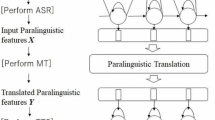Abstract
Although recently there has been significant progress in the general usage and acceptance of speech technology in several developed countries there are still major gaps that prevent the majority of possible users from daily use of speech technology-based solutions. In this paper some of them are listed and some directions for bridging these gaps are proposed. Perhaps the most important gap is the "Black box" thinking of software developers. They suppose that inputting text into a text-to-speech (TTS) system will result in voice output that is relevant to the given context of the application. In case of automatic speech recognition (ASR) they wait for accurate text transcription (even punctuation). It is ignored that even humans are strongly influenced by a priori knowledge of the context, the communication partners, etc. For example by serially combining ASR + machine translation + TTS in a speech-to-speech translation system a male speaker at a slow speaking rate might be represented by a fast female voice at the other end. The science of semantic modelling is still in its infancy. In order to produce successful applications researchers of speech technology should find ways to build-in the a priori knowledge into the application environment, adapt their technologies and interfaces to the given scenario. This leads us to the gap between generic and domain specific solutions. For example intelligibility and speaking rate variability are the most important TTS evaluation factors for visually impaired users while human-like announcements at a standard rate and speaking style are required for railway station information systems. An increasing gap is being built between "large" languages/markets and "small" ones. Another gap is the one between closed and open application environments. For example there is hardly any mobile operating system that allows TTS output re-direction into a live telephone conversation. That is a basic need for rehabilitation applications of speech impaired people. Creating an open platform where "smaller" and "bigger" players of the field could equally plug-in their engines/solutions at proper quality assurance and with a fair share of income could help the situation. In the paper some examples are given about how our teams at BME TMIT try to bridge the gaps listed.
Access this chapter
Tax calculation will be finalised at checkout
Purchases are for personal use only
Preview
Unable to display preview. Download preview PDF.
Similar content being viewed by others
References
Voice Synthesis Nearing Growth Explosion, Computerworld (August 31, 1981)
Brown, M.: The “Lost” Steve Jobs Speech from 1983; Foreshadowing Wireless Networking, the iPad, and the App Store. In: Talk by Steve Jobs at International Design Conference in 1983, October 2 (2012) (retrieved July 2014)
The Global Language Technology Market, LT-Innovate, p. 11 (October 2012)
Handley, Z.: Is text-to-speech synthesis ready for use in computer-assisted language learning? Speech Communication 51(10), 906–919 (2009)
Németh, G., Zainkó, C., Fekete, L., Olaszy, G., Endrédi, G., Olaszi, P., Kiss, G., Kiss, P.: The design, implementation and operation of a Hungarian e-mail reader. International Journal of Speech Technology 3/4, 216–228 (2000)
Németh, G., Zainkó, C., Kiss, G., Olaszy, G., Fekete, L., Tóth, D.: Replacing a Human Agent by an Automatic Reverse Directory Service. In: Magyar, G., Knapp, G., Wojtkowski, W., Wojtkowski, G., Zupancic, J. (szerk.) Advances in Information Systems Development: New Methods and Practice for the Networked Society, pp. 321–328. Springer (2007)
Németh, G., Fék, M., Csapó, T.G.: Increasing Prosodic Variability of Text-To-Speech Synthesizers. In: Interspeech 2007, Antwerpen, Belgium, pp. 474–477 (2007)
Csapó, T.G., Németh, G.: Modeling irregular voice in statistical parametric speech synthesis with residual codebook based excitation. IEEE Journal on Selected Topics In Signal Processing 8(2), 209–220 (2014)
Olaszy, G., Németh, G., Olaszi, P., Kiss, G., Gordos, G.: PROFIVOX - A Hungarian Professional TTS System for Telecommunications Applications. International Journal of Speech Technology 3(3/4), 201–216 (2000)
Csala, E., Németh, G., Zainkó, C.: Application of the NAO humanoid robot in the treatment of marrow-transplanted children. In: Péter, B. (ed.) 2012 IEEE 3rd International Conference on Cognitive Infocommunications (CogInfoCom), Kosice, Slovakia, pp. 655–658 (2012)
Németh, G., Zainkó, Cs., Bartalis, M., Olaszy, G., Kiss, G.: Human Voice or Prompt Generation? Can They Co-Exist in an Application? In: Interspeech 2009: Speech and Intelligence, Brighton, UK, pp. 620–623 (2009)
Klabbers, E.A.M.: High-Quality Speech Output Generation through Advanced Phrase Concatenation. In: COST Telecom Workshop, Rhodes, Greece, pp. 85–88 (September 1997)
Nagy, A., Pesti, P., Németh, G., Bőhm, T.: Design issues of a corpus-based speech synthesizer. HÍRADÁSTECHNIKA LX:(6), 6–12 (2005)
Németh, G., Kiss, G., Tóth, B.: Cross Platform Solution of Communication and Voice/Graphical User Interface for Mobile Devices in Vehicles. In: Abut, H., Hansen, J.H.L., Takeda, K. (eds.) Advances for In-Vehicle and Mobile Systems: Challenges for International Standards, pp. 237–250. Springer (2005)
Tóth, B., Németh, G.: Hidden Markov Model Based Speech Synthesis System in Hungarian. Infocommunications Journal LXIII:(7), 30–34 (2008)
Zainkó, C., Tóth, B.P., Bartalis, M., Németh, G., Fegyó, T.: Some Aspects of Synthetic Elderly Voices in Ambient Assisted Living Systems. In: Burileanu, C., Teodorescu, H.-N., Rusu, C. (eds.) Proceedings of the 7th International Conference Speech Technology and Human-Computer Dialogu, Cluj-Napoca, Romania, pp. 185–189. IEEE, New York (2013)
Németh, G., Olaszy, G., Csapó, T.G.: Spemoticons: Text-To-Speech based emotional auditory cues”m. In: ICAD 2011, Budapest, Magyarország, pp. 1–7. Paper Keynote 3 (2011)
Ethnologue, SIL International (retrieved July 2014)
META-NET White Paper series on Europe’s Languages in the Digital Age (2013), http://www.meta-net.eu/whitepapers/key-results-and-cross-language-comparison (retrieved July 2014)
Németh, G., Zainkó, C.: Multilingual Statistical Text Analysis, Zipf’s Law and Hungarian Speech Generation. Acta Linguistica Hungarica 49:(3-4), 385–405 (2002)
Author information
Authors and Affiliations
Editor information
Editors and Affiliations
Rights and permissions
Copyright information
© 2014 Springer International Publishing Switzerland
About this paper
Cite this paper
Németh, G. (2014). Gaps to Bridge in Speech Technology. In: Ronzhin, A., Potapova, R., Delic, V. (eds) Speech and Computer. SPECOM 2014. Lecture Notes in Computer Science(), vol 8773. Springer, Cham. https://doi.org/10.1007/978-3-319-11581-8_2
Download citation
DOI: https://doi.org/10.1007/978-3-319-11581-8_2
Publisher Name: Springer, Cham
Print ISBN: 978-3-319-11580-1
Online ISBN: 978-3-319-11581-8
eBook Packages: Computer ScienceComputer Science (R0)




